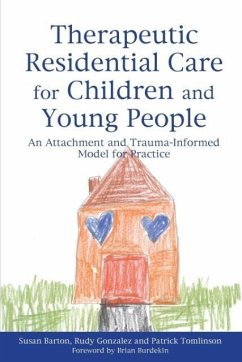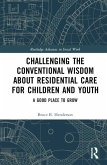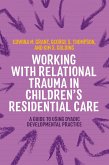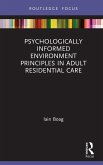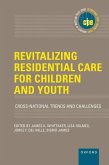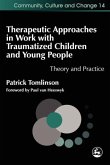Patrick Tomlinson, Rudy Gonzalez, Susan Barton
Therapeutic Residential Care for Children and Young People
An Attachment and Trauma-Informed Model for Practice
Patrick Tomlinson, Rudy Gonzalez, Susan Barton
Therapeutic Residential Care for Children and Young People
An Attachment and Trauma-Informed Model for Practice
- Broschiertes Buch
- Merkliste
- Auf die Merkliste
- Bewerten Bewerten
- Teilen
- Produkt teilen
- Produkterinnerung
- Produkterinnerung
This book provides a model of care for traumatized children, based on theory and practice experience pioneered at the Lighthouse Foundation, Australia. The authors explain the impact of trauma on child development, drawing on psychodynamic, attachment and neurobiological trauma theories.
Andere Kunden interessierten sich auch für
![Challenging the Conventional Wisdom about Residential Care for Children and Youth Challenging the Conventional Wisdom about Residential Care for Children and Youth]() Bruce B. HendersonChallenging the Conventional Wisdom about Residential Care for Children and Youth188,99 €
Bruce B. HendersonChallenging the Conventional Wisdom about Residential Care for Children and Youth188,99 €![Challenging the Conventional Wisdom about Residential Care for Children and Youth Challenging the Conventional Wisdom about Residential Care for Children and Youth]() Bruce B. HendersonChallenging the Conventional Wisdom about Residential Care for Children and Youth57,99 €
Bruce B. HendersonChallenging the Conventional Wisdom about Residential Care for Children and Youth57,99 €![Working with Relational Trauma in Children's Residential Care Working with Relational Trauma in Children's Residential Care]() Kim S. GoldingWorking with Relational Trauma in Children's Residential Care28,99 €
Kim S. GoldingWorking with Relational Trauma in Children's Residential Care28,99 €![Understanding Residential Child Care Understanding Residential Child Care]() Nick FrostUnderstanding Residential Child Care49,99 €
Nick FrostUnderstanding Residential Child Care49,99 €![Psychologically Informed Environment Principles in Adult Residential Care Psychologically Informed Environment Principles in Adult Residential Care]() Iain BoagPsychologically Informed Environment Principles in Adult Residential Care66,99 €
Iain BoagPsychologically Informed Environment Principles in Adult Residential Care66,99 €![Revitalizing Residential Care for Children and Youth Revitalizing Residential Care for Children and Youth]() James K. Whittaker (The School of Social Work at University of WaRevitalizing Residential Care for Children and Youth158,99 €
James K. Whittaker (The School of Social Work at University of WaRevitalizing Residential Care for Children and Youth158,99 €![Therapeutic Approaches in Work with Traumatized Children and Young People Therapeutic Approaches in Work with Traumatized Children and Young People]() Patrick TomlinsonTherapeutic Approaches in Work with Traumatized Children and Young People37,99 €
Patrick TomlinsonTherapeutic Approaches in Work with Traumatized Children and Young People37,99 €-
-
-
This book provides a model of care for traumatized children, based on theory and practice experience pioneered at the Lighthouse Foundation, Australia. The authors explain the impact of trauma on child development, drawing on psychodynamic, attachment and neurobiological trauma theories.
Produktdetails
- Produktdetails
- Verlag: Jessica Kingsley Publishers
- Seitenzahl: 288
- Erscheinungstermin: 1. Oktober 2011
- Englisch
- Abmessung: 229mm x 152mm x 16mm
- Gewicht: 432g
- ISBN-13: 9781849052559
- ISBN-10: 1849052557
- Artikelnr.: 33384413
- Herstellerkennzeichnung
- Libri GmbH
- Europaallee 1
- 36244 Bad Hersfeld
- gpsr@libri.de
- Verlag: Jessica Kingsley Publishers
- Seitenzahl: 288
- Erscheinungstermin: 1. Oktober 2011
- Englisch
- Abmessung: 229mm x 152mm x 16mm
- Gewicht: 432g
- ISBN-13: 9781849052559
- ISBN-10: 1849052557
- Artikelnr.: 33384413
- Herstellerkennzeichnung
- Libri GmbH
- Europaallee 1
- 36244 Bad Hersfeld
- gpsr@libri.de
Susan Barton is Honorary Visiting Research Fellow at De Montfort University, UK. She is the author of Working-Class Organisations and Popular Tourism, 1840-1970 (2005) and Healthy Living in the Alps: The Origins of Winter Tourism in Switzerland, 1860-1914 (2008). She is also the co-editor, along with Allan Brodie, of the four-volume Travel and Tourism in Britain, 1700-1914 (2014).
Foreword. Acknowledgements. Authors' Note. Introduction. What is child
abuse and neglect? The cost of abuse. The need for early intervention,
treatment and prevention. 1. The Importance of a Theoretical Base. The
relationship between theory and practice. Theory in the caring professions.
Psychodynamic thinking. Psychodynamic concepts. The relationship between
the organization and therapeutic task. The treatment approach. Attachment
and trauma-informed theories. The influence of Winnicott on therapeutic
residential care. Individual, family, community and societal wellness
theory. Conclusion. 2. Trauma-Informed Practice. How traumatization
develops in childhood. Trauma causes hyperarousal and fear in children.
Childhood trauma reduces the brain's capacity to think and regulate
emotions. Trauma disconnects children from relational resources. Trauma
restricts the attention capacity of children. Trauma-based behaviour has a
functional purpose. Trauma restricts children's ability to deal with
change. Trauma undermines identity formation in children. Trauma affects
social skills development and impacts on peer relationships. The impact of
trauma on the child's internal working model. Relationship and attachment
difficulties. Physical wellbeing. The basics of trauma treatment. 3.
Therapeutic Relationships. Beginnings. Information gathering and
assessment. The intake process. Attachment. Secure base. Commitment.
Continuity of care. Working with loss. Role modelling. Personal growth.
Creating capacity for relationship building: one-to-one time with children.
Unique needs. The importance of the relationship when challenging
behaviour. Challenging behaviour as a sign of hope. The role of touch in
the healing process. Consequences vs punishment. Promoting responsible
children (empowerment processes). Participation of children and young
people in the organization. 4. Demands and Rewards of the Work: Staff
Support. Working with challenging and aggressive behaviour. Physical and
emotional wellbeing. Working with anxiety. Communication challenges.
Therapeutic supervision: working with feelings. Safety and containment. The
impact of trauma work on our own memories and experiences of childhood. 5.
The Home Environment. Home aesthetics. Encouraging play and curiosity.
Privacy and security. 6. The Holding Environment and Daily Routines.
Routines, limits and anchor points. Daily programme. Use of television and
computers. Free time. The importance of food in the healing process.
Bedtime and waking routines. Play. Celebrations as a sense of belonging. 7.
The Organization and Community. The language of the organization. Trauma
re-enactment and its impact on the organization. Management and the
therapeutic task. The lighthouse foundation as an open system. Leadership.
Authority. Managing change. The organization's vision. Sense of community.
Sense of family and home. Organization as family. Local community.
Community committees as a containing membrane. Collective wellness. 8.
Group Processes. 'I feel like saying' process. Shared history: culture
passed on through stories. Strong culture. Child safety. Reflective
practice. Emotional intelligence. Emotional wellness. Transparency and
openness. Family meetings. Combined family meetings. Whole family meetings.
Youth forums. Clinical supervision (relationship between carers). Clinical
peer supervision (carers' meeting). Mediation processes. 9. Moving On:
Transitions, Aftercare and Outreach. Transition as a separation experience.
Life membership. Transitional planning and transitional objects. Transition
celebrations. Stepping stones: transitional programmes. Assessing readiness
for transition. Carer relationship beyond transition. Aftercare programme.
Outreach. Children returning to work with the organization. 10.
Outcomes-Based Practice. Outcomes-based approaches. The need for evidence.
Measuring outcomes. Difficulties in measuring outcomes. Potential benefits
and value of developing an outcomes-based approach. Appendix 1 Susan's
Story. Appendix 2 The Lighthouse Therapeutic Family Model of Care. About
the Authors. References. Index.
abuse and neglect? The cost of abuse. The need for early intervention,
treatment and prevention. 1. The Importance of a Theoretical Base. The
relationship between theory and practice. Theory in the caring professions.
Psychodynamic thinking. Psychodynamic concepts. The relationship between
the organization and therapeutic task. The treatment approach. Attachment
and trauma-informed theories. The influence of Winnicott on therapeutic
residential care. Individual, family, community and societal wellness
theory. Conclusion. 2. Trauma-Informed Practice. How traumatization
develops in childhood. Trauma causes hyperarousal and fear in children.
Childhood trauma reduces the brain's capacity to think and regulate
emotions. Trauma disconnects children from relational resources. Trauma
restricts the attention capacity of children. Trauma-based behaviour has a
functional purpose. Trauma restricts children's ability to deal with
change. Trauma undermines identity formation in children. Trauma affects
social skills development and impacts on peer relationships. The impact of
trauma on the child's internal working model. Relationship and attachment
difficulties. Physical wellbeing. The basics of trauma treatment. 3.
Therapeutic Relationships. Beginnings. Information gathering and
assessment. The intake process. Attachment. Secure base. Commitment.
Continuity of care. Working with loss. Role modelling. Personal growth.
Creating capacity for relationship building: one-to-one time with children.
Unique needs. The importance of the relationship when challenging
behaviour. Challenging behaviour as a sign of hope. The role of touch in
the healing process. Consequences vs punishment. Promoting responsible
children (empowerment processes). Participation of children and young
people in the organization. 4. Demands and Rewards of the Work: Staff
Support. Working with challenging and aggressive behaviour. Physical and
emotional wellbeing. Working with anxiety. Communication challenges.
Therapeutic supervision: working with feelings. Safety and containment. The
impact of trauma work on our own memories and experiences of childhood. 5.
The Home Environment. Home aesthetics. Encouraging play and curiosity.
Privacy and security. 6. The Holding Environment and Daily Routines.
Routines, limits and anchor points. Daily programme. Use of television and
computers. Free time. The importance of food in the healing process.
Bedtime and waking routines. Play. Celebrations as a sense of belonging. 7.
The Organization and Community. The language of the organization. Trauma
re-enactment and its impact on the organization. Management and the
therapeutic task. The lighthouse foundation as an open system. Leadership.
Authority. Managing change. The organization's vision. Sense of community.
Sense of family and home. Organization as family. Local community.
Community committees as a containing membrane. Collective wellness. 8.
Group Processes. 'I feel like saying' process. Shared history: culture
passed on through stories. Strong culture. Child safety. Reflective
practice. Emotional intelligence. Emotional wellness. Transparency and
openness. Family meetings. Combined family meetings. Whole family meetings.
Youth forums. Clinical supervision (relationship between carers). Clinical
peer supervision (carers' meeting). Mediation processes. 9. Moving On:
Transitions, Aftercare and Outreach. Transition as a separation experience.
Life membership. Transitional planning and transitional objects. Transition
celebrations. Stepping stones: transitional programmes. Assessing readiness
for transition. Carer relationship beyond transition. Aftercare programme.
Outreach. Children returning to work with the organization. 10.
Outcomes-Based Practice. Outcomes-based approaches. The need for evidence.
Measuring outcomes. Difficulties in measuring outcomes. Potential benefits
and value of developing an outcomes-based approach. Appendix 1 Susan's
Story. Appendix 2 The Lighthouse Therapeutic Family Model of Care. About
the Authors. References. Index.
Foreword. Acknowledgements. Authors' Note. Introduction. What is child
abuse and neglect? The cost of abuse. The need for early intervention,
treatment and prevention. 1. The Importance of a Theoretical Base. The
relationship between theory and practice. Theory in the caring professions.
Psychodynamic thinking. Psychodynamic concepts. The relationship between
the organization and therapeutic task. The treatment approach. Attachment
and trauma-informed theories. The influence of Winnicott on therapeutic
residential care. Individual, family, community and societal wellness
theory. Conclusion. 2. Trauma-Informed Practice. How traumatization
develops in childhood. Trauma causes hyperarousal and fear in children.
Childhood trauma reduces the brain's capacity to think and regulate
emotions. Trauma disconnects children from relational resources. Trauma
restricts the attention capacity of children. Trauma-based behaviour has a
functional purpose. Trauma restricts children's ability to deal with
change. Trauma undermines identity formation in children. Trauma affects
social skills development and impacts on peer relationships. The impact of
trauma on the child's internal working model. Relationship and attachment
difficulties. Physical wellbeing. The basics of trauma treatment. 3.
Therapeutic Relationships. Beginnings. Information gathering and
assessment. The intake process. Attachment. Secure base. Commitment.
Continuity of care. Working with loss. Role modelling. Personal growth.
Creating capacity for relationship building: one-to-one time with children.
Unique needs. The importance of the relationship when challenging
behaviour. Challenging behaviour as a sign of hope. The role of touch in
the healing process. Consequences vs punishment. Promoting responsible
children (empowerment processes). Participation of children and young
people in the organization. 4. Demands and Rewards of the Work: Staff
Support. Working with challenging and aggressive behaviour. Physical and
emotional wellbeing. Working with anxiety. Communication challenges.
Therapeutic supervision: working with feelings. Safety and containment. The
impact of trauma work on our own memories and experiences of childhood. 5.
The Home Environment. Home aesthetics. Encouraging play and curiosity.
Privacy and security. 6. The Holding Environment and Daily Routines.
Routines, limits and anchor points. Daily programme. Use of television and
computers. Free time. The importance of food in the healing process.
Bedtime and waking routines. Play. Celebrations as a sense of belonging. 7.
The Organization and Community. The language of the organization. Trauma
re-enactment and its impact on the organization. Management and the
therapeutic task. The lighthouse foundation as an open system. Leadership.
Authority. Managing change. The organization's vision. Sense of community.
Sense of family and home. Organization as family. Local community.
Community committees as a containing membrane. Collective wellness. 8.
Group Processes. 'I feel like saying' process. Shared history: culture
passed on through stories. Strong culture. Child safety. Reflective
practice. Emotional intelligence. Emotional wellness. Transparency and
openness. Family meetings. Combined family meetings. Whole family meetings.
Youth forums. Clinical supervision (relationship between carers). Clinical
peer supervision (carers' meeting). Mediation processes. 9. Moving On:
Transitions, Aftercare and Outreach. Transition as a separation experience.
Life membership. Transitional planning and transitional objects. Transition
celebrations. Stepping stones: transitional programmes. Assessing readiness
for transition. Carer relationship beyond transition. Aftercare programme.
Outreach. Children returning to work with the organization. 10.
Outcomes-Based Practice. Outcomes-based approaches. The need for evidence.
Measuring outcomes. Difficulties in measuring outcomes. Potential benefits
and value of developing an outcomes-based approach. Appendix 1 Susan's
Story. Appendix 2 The Lighthouse Therapeutic Family Model of Care. About
the Authors. References. Index.
abuse and neglect? The cost of abuse. The need for early intervention,
treatment and prevention. 1. The Importance of a Theoretical Base. The
relationship between theory and practice. Theory in the caring professions.
Psychodynamic thinking. Psychodynamic concepts. The relationship between
the organization and therapeutic task. The treatment approach. Attachment
and trauma-informed theories. The influence of Winnicott on therapeutic
residential care. Individual, family, community and societal wellness
theory. Conclusion. 2. Trauma-Informed Practice. How traumatization
develops in childhood. Trauma causes hyperarousal and fear in children.
Childhood trauma reduces the brain's capacity to think and regulate
emotions. Trauma disconnects children from relational resources. Trauma
restricts the attention capacity of children. Trauma-based behaviour has a
functional purpose. Trauma restricts children's ability to deal with
change. Trauma undermines identity formation in children. Trauma affects
social skills development and impacts on peer relationships. The impact of
trauma on the child's internal working model. Relationship and attachment
difficulties. Physical wellbeing. The basics of trauma treatment. 3.
Therapeutic Relationships. Beginnings. Information gathering and
assessment. The intake process. Attachment. Secure base. Commitment.
Continuity of care. Working with loss. Role modelling. Personal growth.
Creating capacity for relationship building: one-to-one time with children.
Unique needs. The importance of the relationship when challenging
behaviour. Challenging behaviour as a sign of hope. The role of touch in
the healing process. Consequences vs punishment. Promoting responsible
children (empowerment processes). Participation of children and young
people in the organization. 4. Demands and Rewards of the Work: Staff
Support. Working with challenging and aggressive behaviour. Physical and
emotional wellbeing. Working with anxiety. Communication challenges.
Therapeutic supervision: working with feelings. Safety and containment. The
impact of trauma work on our own memories and experiences of childhood. 5.
The Home Environment. Home aesthetics. Encouraging play and curiosity.
Privacy and security. 6. The Holding Environment and Daily Routines.
Routines, limits and anchor points. Daily programme. Use of television and
computers. Free time. The importance of food in the healing process.
Bedtime and waking routines. Play. Celebrations as a sense of belonging. 7.
The Organization and Community. The language of the organization. Trauma
re-enactment and its impact on the organization. Management and the
therapeutic task. The lighthouse foundation as an open system. Leadership.
Authority. Managing change. The organization's vision. Sense of community.
Sense of family and home. Organization as family. Local community.
Community committees as a containing membrane. Collective wellness. 8.
Group Processes. 'I feel like saying' process. Shared history: culture
passed on through stories. Strong culture. Child safety. Reflective
practice. Emotional intelligence. Emotional wellness. Transparency and
openness. Family meetings. Combined family meetings. Whole family meetings.
Youth forums. Clinical supervision (relationship between carers). Clinical
peer supervision (carers' meeting). Mediation processes. 9. Moving On:
Transitions, Aftercare and Outreach. Transition as a separation experience.
Life membership. Transitional planning and transitional objects. Transition
celebrations. Stepping stones: transitional programmes. Assessing readiness
for transition. Carer relationship beyond transition. Aftercare programme.
Outreach. Children returning to work with the organization. 10.
Outcomes-Based Practice. Outcomes-based approaches. The need for evidence.
Measuring outcomes. Difficulties in measuring outcomes. Potential benefits
and value of developing an outcomes-based approach. Appendix 1 Susan's
Story. Appendix 2 The Lighthouse Therapeutic Family Model of Care. About
the Authors. References. Index.

